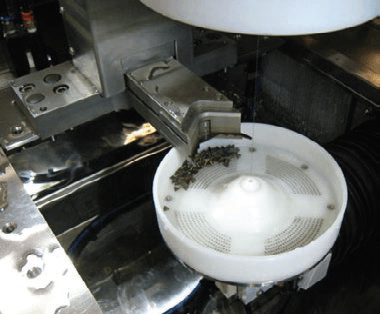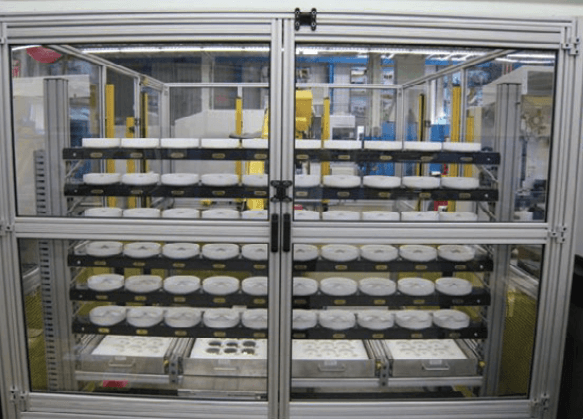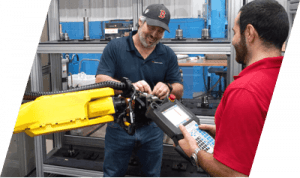
Case Study
Diamond Innovations Makes Advanced Wire EDM Automation a Reality
[EDM Today]
Request Information
Problem
Diamond Innovations determined that two variables in their EDM operations were producing inconsistent results, individual unique tooling and operator error due to manual part loading.
Solution
The team determined they could improve product repeatability, accuracy and productivity by incorporating more complete process automation.
Results
- Reduced time and cost by 60% per assembly.
- All assembly components were now being machined simultaneously in just one machine cycle.
- Mostly unattended 2nd, 3rd, and weekend shifts were added to production.

Company
Diamond Innovations, Inc.
Location
Columbus, Ohio
Website
www.diamondinnovations.com
Bring Advanced EDM Automation to Reality
About Diamond Innovations, Inc.
In keeping with their name, Diamond Innovations, Inc. (Columbus, OH U.S.A.) continuously seeks the latest, innovative manufacturing processes to serve their customers with diamond and cubic boron nitride products. Diamond Innovations, a wholly owned subsidiary of Sandvik AB, is a world leading manufacturer of superabrasive products used for material removal, and was the inventor and world’s first mass producer of manufactured diamond for the grinding of tungsten carbide in 1955. Since that time, Diamond Innovations products have grown to serve the electronic, aerospace, infrastructure construction, energy exploration, mining, and automotive industries.
Among other products, Diamond Innovations manufactures over three thousand PCD (polycrystalline diamond) and PCBN (polycrystalline cubic boron nitride) cut part geometries that are incorporated in high productivity cutting tools for the metalworking industry. Approximately 90% of the parts are custom made to order in quantities ranging from 1 to over 50,000 pieces. The typical order quantity is 200. Reliable, on time delivery of high quality inserts are key customer requirements.
Confronting the Challenges
EDM cutting technology is a key production method that has served Diamond Innovations very well for manufacturing the PCD / PCBN parts. While CNC EDM machine tools have been used for decades, full process automation was not applied. Mr. Steve Chadwick, Diamond Innovations Operations Manager said, “The quality of the product was not at the optimal level we sought for our demanding customer base. We determined that two variables in our EDM operations were producing inconsistent results – individual unique tooling and operator error due to manual part loading.”
Customer dimensional tolerances vary, but can be as stringent as +/- .02 mm. Consistency is an integral part of producing a high quality product at Diamond Innovations. Chadwick’s team determined they could improve product repeatability, accuracy and productivity by incorporating more complete process automation.
Diamond Innovations challenged several EDM providers, including their long-time partner, FANUC supplier Methods Machine Tools, Inc. (Sudbury, MA U.S.A.), to eliminate the inconsistencies and provide a fully automated solution that would increase flexibility and capacity without adding to labor costs. At the same time, Diamond Innovations examined their Wire EDM technology to ensure they were using the best the industry had to offer.

To assess product quality, Chadwick’s team sent a “test cut package” to several EDM suppliers that included several different grades and shapes of PCD material, including rectangular, round and triangular tips. When all of the cut parts and results were returned for inspection / tabulation, it was determined that the FANUC RoboCut Wire EDM from Methods Machine Tools was the most effi – cient, resulting in the fastest cutting speed and highest quality parts.
The second challenge facing Diamond Innovations and Methods was not as straight-forward. Customer orders require short EDM runs of dissimilar parts which are historically not thought to be conducive to full automation. Diamond Innovations cuts customer parts from master blank disks ranging from 0.8 mm to 5 mm in thickness and from 50 to 70mm in diameter. These master blanks also added to the automation challenge. The blanks, constructed of synthetic PCD diamond with different sizes of diamond particles, which range from 1 micron to 25 microns, each require specific EDM parameters for optimum quality. The PCD is typically attached to a thin tungsten carbide back to give it strength. Shapes vary, including rectangles, rounds, triangles and more. Many of the pieces are exceedingly difficult to load, clamp and unload in a precise position.
Despite all the variables, Methods and Diamond Innovations were comfortable with the challenge and jointly developed unique and effective approaches to this complex operation – a machine “cell” design concept for automating the loading/ unloading parts and optimizing cut quality. Work began in 2009 and Diamond Innovations targeted implementation beginning in 2011.
Automated Cell Process
- When one of the three FANUC Wire EDM machines finishes cutting it sends a signal to the Cell Controller software that it is now available for servicing
- The robot reaches in and unloads the finished part basket with all the pieces from the last disk and places the basket back on the rack
- The robot picks up an empty basket corresponding to the next incoming part and loads the basket into the machine.
- Then the robot picks up a disk from the next designated drawer position. It places that disc in a centering station that corrects for the differences in diameter and loads it into the part holding fixture in the machine.
- The disk is then measured with the laser to confirm flatness, and is corrected as necessary.
- The cycle is then restarted
Automate, Fixture, Inspect and Ship
The jointly developed cell solution addressed several variables. The first was designing an automated solution to load / unload parts by incorporating three FANUC RoboCut Wire EDM machines being serviced by one FANUC M20iA robot into one cell. One side of the cell is an “operator station” where drawers are located for introducing raw parts into the cell and a rack that holds baskets for catching and removing the cut PCD parts. The automatic loading system eliminated the need to have an operator standing by to load and unload the parts. Chadwick said, “Now we can load blanks on Friday, leave for the weekend, and come in on Monday to finished parts.”
The second design challenge was a special pneumatic clamping fixture in each machine to accept the varying disk sizes and locate the part being loaded by a robot. Typically the master PCD blank is placed in a fixture which is mounted on a pallet system that locates the part precisely in the machine. “We needed to find a way to grab the smallest edge of a disk in order to fully machine it. In EDM set-ups, these type of fixtures are uncommon,” said Mr. John Lucier, Automation Manager at Methods Machine Tools. “On top of this, all of the components such as proximity switches etc., needed to be made of stainless because they are fully submerged in water.” The clamping solution did not require the expensive pallet and custom tooling solution that Diamond Innovations previously utilized. This provided savings to the overall project. “We started with three cells which altogether contain 180 blanks of varying sizes. “It would be very costly to purchase individual fixtures and pallets designed for each part,” said Mr. Richard Mercurio, Advanced Manufacturing Engineer at Diamond Innovations. Important productivity gains were achieved. Instead of manually clamping each disk on to a pallet, an operator only needs to place the raw disk in a drawer position which takes a fraction of the time and easily facilitates unattended operations. The clamped PCD disk must be held both fl at and parallel to the EDM machine axes. Before the automated solution, if a disk was not clamped within specification, the operator was required to manually unclamp, rotate, re-clamp and re-inspect the disk. This process might require several attempts before meeting the required tolerance. With the automated solution, a robot-mounted laser displacement sensor is used to measure the fl atness of the blank as it is held in the fi xture. After the blank is loaded into the EDM machine, the robot positions the laser over the part and takes several measurements to ensure the disk is located within tolerance. If the disk is not within these parameters, the robot repeats the procedure at precise, calculated adjustments until an acceptable result is achieved. “Now with clamped tolerance being automatically determined, requiring no manual operator intervention, we gain substantial consistency and unattended operation – which is the best of both worlds,” explained Chadwick.
Methods incorporated its latest exclusive technology so the cutting program addressed the different thicknesses and grades of PCD. A cell-controlled computer has specially designed MMAC software (Methods Manufacturing Automation Control) which allows the cell operator to identify and prioritize each of the 60 incoming parts in the cells. When one of the EDM machines in a cell becomes available,
The MMAC software will direct the robot to pick-up the next part on the job list and send the proper cutting parameters to the machine’s controller. The Methods MMAC software stores measurement data taken by the laser sensor, identifies which cut part is in which basket, presents an easy-to-interpret visual on cell operations status, and will assist in the automatic recovery of the cell in the event of an unexpected stoppage.
Finally, Diamond Innovations set a goal to eliminate all cut part mix-ups. Once cut in the EDM, the several grades of PCD tips are very difficult to identify, and mix-ups, while not common, can escape to customers. The solution was custom designed parts-catching baskets to collect cut parts. The basket design prevents product chipping and prevents small cut parts from being lost, displaced by EDM water circulation. These solutions increase process yield.
The FANUC Wire EDM machines are designed to work exceptionally well in an automated cell set-up. For example, the machines include an enhanced Fanuc Auto Wire Feed (AWF2) system that can thread while submerged through the start hole of a workpiece up to a maximum thickness of 8.0” (200 mm). In the event of a wire break, the FANUC Ai auto wire repair system can thread through the kerf while submerged to a depth ranging to 6.0” (150 mm) without returning to the start point. This feature is a must when cutting these types of materials.
Methods worked closely with Diamond Innovations to phase in the EDM cells. This permitted Diamond Innovations to realize the advantages of the new technology while investing in stages, providing a more affordable solution as capacity increased.

“The automated process cell solution is something we had never tried in the past. We worked closely together on the design for two years, Methods provided a flawless installation and we were in full production within six weeks. It has exceeded our expectations by every measure. We estimate a productivity increase of 20%.”
Exceeding Expectations
Diamond Innovations has realized three overall benefits from its investment – increased consistency, higher quality and gains in capacity. The scrap rate from cutting errors is now negligible, due largely to the automated fixturing and inspection processes. This improvement is justifying the project investment.
In addition, Chadwick reports their customers are more satisfied. “The cutting quality on the FANUC Wire EDM’s is more consistent than on other machines we’ve looked at, and the tooling on the automated cell optimizes each process to ensure we achieve the highest part quality at the highest productivity,” continued Chadwick.
After installation of the automation solution, Diamond Innovations now operates 40% more EDM machines with the same production staff. Chadwick put it best when he said, “Robots can do some things that people can’t do. Robots free up people so they can do what is most important. We still have the same number of staff after we automated, but we increased capacity significantly.”
Diamond Innovations added a fourth cell in 2012, and with Methods, continues to automate their EDM processes. They are currently evaluating an automated guided vehicle system to service the cells. This new process design has the potential to decrease required floor space by 33% and allow the staging and processing of 50 blanks per WEDM instead of 20.
“I have six excellent people who know how to run the cells. They own the operation and I have no concerns,” Chadwick said. “With these cells, we are on the cutting edge of continuous improvement and the technology frees us up to look for even more ways to optimize and innovate.”
